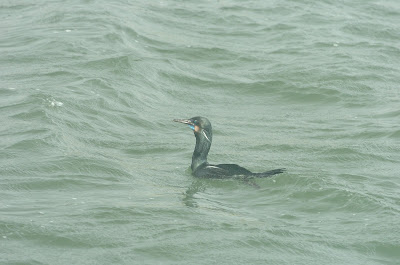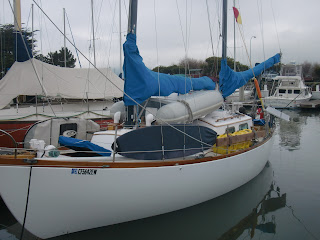As we celebrated the conclusion of our
preparations, three days after our first intended departure date, the
sun fell to the southwest behind a fog that enshrined the Bridge and
surrounding landscape. It was just as we were used to seeing it. The
sky was tinted light red- the resemblance of this winter view of home
to its typical summer likeness was not lost on us. We sipped beers
nestled in s/v Ardea coozies and pondered...
On Thursday we awoke to more summer
weather. There was a decent breeze early and fog all over the Bay.
Dana managed to finagle some breakfast buffet tickets for himself,
his super-employed girlfriend, Robin, Taylor and me, so we ate in
style at the Doubletree. The morning went by quickly. Friends and
family came down to the docks around noon to see how similar our
vessel looked to the Merry Prankster's schoolbus. And to say goodbye
of course.
It was emotional for all of us. I
already miss my wonderful family and all my dockmates and friends at
the marina. Despite the anticipation, all the time and effort, and
the excitement for what lay in store, I found myself struggling with
the thought of leaving my family for so long. Our trip is open-ended
though, and I reminded myself that we meant to include the
possibility of shortening it and that we respected the fact that we
really don't know how we will feel about cruising sailboats even a
month from now. So we take it slow and remain open.
We pushed off around 1300 waving
goodbyes and following Eventide who carried some of the incredible
people from Berkeley Marina out with Ardea. The fog broke and we had
a great sail out to Angel Island. Eventide with a reef in her
mainsail was doing laps around Ardea.
After Eventide turned back, we sailed
up Raccoon Straights and got a visit from our SFYC friends, Rob and
Forrest. They drove alongside and we all joked about the obvious
hilarity and excitement regarding three large dudes on one little
boat loaded down with everything you could imagine and embarking.
Spirits were high, but once they left we didn't have much time to
mess around. The Bridge was again covered by a heavy fog bank and the
sun was getting pretty low. It would be nearly dark before we made it
to Mile Rock and our pleasant afternoon sail was going to get cold
pretty quick. Before we hit the fog bank, we were all in foulies and
harnessed.
Though visibility wasn't great, we
didn't have a problem navigating out to the Ocean. We could see the
commercial traffic on our plotter using AIS and we had radar and
charts to keep us out of the shipping lanes and away from the rocks.
We tacked a narrow beat up the North side of the waterway with the
outbound shipping lane to port and the Marin headlands to starboard.
The fog dissipated gradually while we made our way West. As it
coasted from within the clouds, we gauged our visibility from an
incoming tanker's position on the plotter; we could see to about 1
nautical mile. We tacked as the tanker passed to port and headed
southwest.
 |
| Golden Gate Bridge barely visible. |
The seas were rather large- about 15
feet every 15-20 seconds. None of us has ever been seasick, but all
of us were close. Nobody wanted to go below. More than a minute or
two in the cabin meant growing nausea for Ardea's crew. Internal
conflicts plagued us quietly; I waited an inordinate amount of time
before getting another layer to combat the cold that settles in with
night and the sedentary act of sailing 14,000 pounds of displacement
hull. Chittick decided to wait on getting the next chart out. Dana
became much less motivated to make coffee. We were all feeling it...
Then the waves got steeper. About 3.5
nm west of Ocean Beach (naturally). It was uncomfortable for a bit.
Enough so that we fired up the engine and made a faster and more
westerly course. It was a bit disconcerting at the time, but it's all
relative.
Night settled and we decided to have
two-man watches for the time being. It was our first day- an
emotional and exhausting one- and we were still in fairly heavy fog.
Dana and I sat the first watch. We sat silently in the cockpit for a
long time, each of us living in our own heads. There was a lot to
process. And our bones shook.
Chittick had been sleeping on and off
for about 2.5 hours of his 3 hour break when Dana and I checked the
plotter and saw a chance for respite. We were about 10 nm offshore at
that point and while the waves weren't nearly as steep, the wind from
the southwest was blowing strong enough that we put two reefs in the
main and it was a bumpy ride. We were hungry but couldn't eat and
tired but couldn't sleep. It didn't take long before we decided to
gybe and aim for Half Moon Bay. I said, in a quiet monotone that
perhaps only the combination of lingering near-sickness and freezing
cold can generate, “just thinking about it makes me happy- we
should go.” We figured at 1930 that we could be at anchor by 2130,
make some dinner and get a good night's sleep. It sounded real nice.
Pretty soon, Chittick was back on watch
and I went below to try to catch a snooze and get warm before we got
to Pillar Point Harbor. The rest did me well, though I didn't sleep.
Eventually, after encountering an uncharted buoy, Chittick and Dana
were on edge. When I got my foulies back on and went topside, I
understood why. The fog was thick and the wind was getting lighter.
We could see well enough and the approach was simple and well marked,
so we decided to press on in the fog. With all three of us on watch,
we kept a sharp eye. The seas had dissipated significantly as
forecast; we wouldn't have made the approach had they been anywhere
near what we had on the way out.
As we got to about 3 nm out and well
lined up for the approach, we decided to fire up the Perkins. As
usual, it fired up just fine. Then it quit. We turned it over and
over and it wouldn't fire again. We couldn't determine what the issue
was and we didn't want to run our batteries out cranking it. We
figured the engine might be flooded after so much cranking and
choking anyway, so we let it rest. The wind was still decent.
About 1 nm from the harbor entrance,
the wind dissipated. By now it was about 2100. The swell was still
small and periodical gusts kept us making a bit of progress, so we
pressed on. We readied the anchor; if we stopped making headway, we
could anchor there at a depth of 40 feet or so and wait for Vessel
Assist. Eventually, we hailed Vessel Assist and had them on standby
to give us a tow into the harbor. Needless to say, the engine still
wasn't firing. But when I was talking to Vessel Assist, the harbor
patrol at Pillar Point Harbor broke in and advised we keep on
sailing. We switched to a side channel on the VHF and he assured us
the approach was wide and that we could drop anchor at any point on
the way and be fine. So we sailed on, checking in with the Harbor
Patrol regularly for the last hour or so.
All in all, it took us about three
hours to cover that last mile. At one point, I was on the bow with an
oar so that we could maneuver better. Chittick was cursing the 2
knots of breeze that came and went. Dana was trying to work the jib
enough to get the boat to tack- even that little swell makes it tough
to tack in this boat when you haven't got much momentum. But we made
it in and dropped the anchor and were overcome with a sense of
relief. Even without an engine, we navigated safely and were prepared
for the situation. And we were rewarded for getting on the VHF early,
as the guidance and local knowledge of our friend at Pillar Point
Marina saved us paying for a tow.
Deeply, deeply exhausted, we ate a
small, mediocre meal cooked in a receptacle some of us believe to be
a cooking pot and others believe to be a mere metallic storage
container. We passed out with some sense of accomplishment, even
though we only made it a few miles south of San Francisco.
.JPG) |
| Easy to understand what's going on when it's a clear day at HMB. |
We all awoke slowly Friday morning. The
weather was beautiful, but I for one was not excited to find out
whether or not Ardea's engine was destroyed. After a good breakfast
and two or three hours of tinkering, we got her started up. We had
air in the fuel line and due to all of our impatient cranking, we had
to bleed the whole system, from the injectors to the secondary fuel
pump. It was a pain in the ass, but when it finally fired up, we were
all screaming with joy. We suspect the air got into the line through
a poorly seated gasket on one of the filters or a loose hose clamp on
the fuel line. We had replaced all the filters and the fuel line
itself a week or so before leaving. So, we re-checked and
re-tightened at all of those spots in the hopes of avoiding the
situation in the future.
It's been ups and downs, literally and
figuratively, but the first 24 hours of our trip were good for all of
us. Though humbled, we're proud of the way we handled the situation
and certainly can't complain about an opportunity to learn more about
diesel engines. Lessons safely learned, spirits are high again. We
spent Friday night relaxing in Half Moon Bay and pushed off again in
the morning, this time with smaller seas and a 10-20 knot northerly.
After all, it's adventure we wanted...
.JPG)

.JPG)










.JPG)











